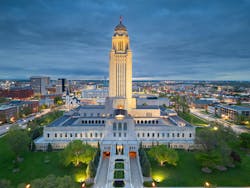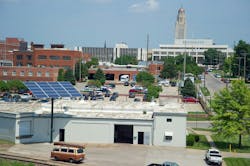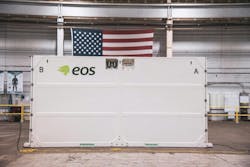Lincoln Electric System Adding Battery Storage to Community Microgrid
Nebraska utility Lincoln Electric System has signed two industry partners to develop and build a battery energy storage system (BESS) which will connect with its existing community microgrid.
Lincoln Electric System has signed an agreement with energy storage software firm WATTMORE and project financier and asset owner Bridge Renewable Energy to work together on building a 3-MW/12-MWh BESS to serve several purposes within the utility’s grid.
One of those purposes is supporting an existing community microgrid, as well as strengthening the balance and resiliency of the local electric grid. Lincoln also will use the project to gain more hands-on experience with battery storage, which often offers more data points to analyze than other types of power generation.
“As we look for new ways to provide reliable, affordable clean energy to our customers, we’re pleased to partner with Bridge and WATTMORE on a state-of-the-art energy storage system that opens the door to understanding the important role such assets will play in the future of the grid,” Emeka Anyanwu, CEO of Lincoln Electric System, said in a statement.
The battery storage will be located near a substation in Lincoln, connected to the local transmission and distribution grid. It also will offer backup power support to the community microgrid that provides grid services and electricity if an outage happens in the downtown Lincoln area.
Battery storage firm Eos will supply the 12-MWh BESS using its third-generation Eos Znyth technology, which is powered by zinc aqueous batteries. The company notes that the BESS components and assembly are entirely in the United States.
“This project demonstrates the critical role energy storage plays in powering our economy, enhancing the reliability and security of our energy systems, and driving us towards our clean energy goals,” Justin Vagnozzi, senior vice president of global sales at Eos, said.
Lincoln Electric System, which has explored the potential of community microgrids for nearly a decade, commissioned the project in 2020. The power generation resources currently fueling the microgrid include nearly 300 kW of solar, six hours of thermal energy storage at 500 kW and a 30-MW natural gas-powered generator.
The LES Community Microgrid can provide backup power for critical downtown loads such as the arena, federal building, city and county services, state offices and the State Capitol, according to the utility’s website about the project.
Lincoln Electric Service overall connects electricity to more than 150,000 customers and is a member of the Large Public Power Council.
Utility microgrids will be part of Microgrid Knowledge Conference 2025
About the Author
Rod Walton, Microgrid Knowledge Managing Editor
Managing Editor
For Microgrid Knowledge editorial inquiries, please contact Managing Editor Rod Walton at [email protected].
I’ve spent the last 15 years covering the energy industry as a newspaper and trade journalist. I was an energy writer and business editor at the Tulsa World before moving to business-to-business media at PennWell Publishing, which later became Clarion Events, where I covered the electric power industry. I joined Endeavor Business Media in November 2021 to help launch EnergyTech, one of the company’s newest media brands. I joined Microgrid Knowledge in July 2023.
I earned my Bachelors degree in journalism from the University of Oklahoma. My career stops include the Moore American, Bartlesville Examiner-Enterprise, Wagoner Tribune and Tulsa World, all in Oklahoma . I have been married to Laura for the past 33-plus years and we have four children and one adorable granddaughter. We want the energy transition to make their lives better in the future.
Microgrid Knowledge and EnergyTech are focused on the mission critical and large-scale energy users and their sustainability and resiliency goals. These include the commercial and industrial sectors, as well as the military, universities, data centers and microgrids. The C&I sectors together account for close to 30 percent of greenhouse gas emissions in the U.S.
Many large-scale energy users such as Fortune 500 companies, and mission-critical users such as military bases, universities, healthcare facilities, public safety and data centers, shifting their energy priorities to reach net-zero carbon goals within the coming decades. These include plans for renewable energy power purchase agreements, but also on-site resiliency projects such as microgrids, combined heat and power, rooftop solar, energy storage, digitalization and building efficiency upgrades.



